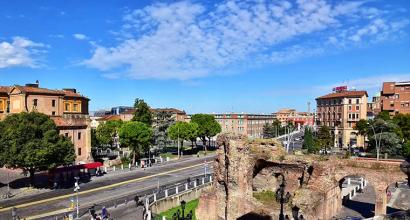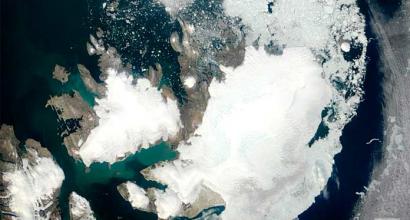That there is a volcano eruption in Bali. Activity at Bali's Agung volcano has reached a 'critical stage'
Last day of Bali. How to avoid becoming a victim of a volcanic eruption
On the island of Bali, popular destination for tourists from all over the world, is about to wake up ancient volcano, dormant for more than half a century. Now there is huge number tourists, among them there are also residents of Russia. 360 hopes everyone can get out of the eruption before it starts, but we've put together some guidance on how to stay as safe as possible before, during and after the disaster.
Max Pixel
What's happening? Volcano Agung on the island of Bali (Indonesia), dormant since 1963, has begun to awaken, with giant columns of ash flying from its vent into the air. The country's authorities announced the need to evacuate 100 thousand people from the surrounding area. Of these, more than 50 thousand are tourists, among whom there are Russians (300 people only according to official data). At the same time, the airport in Denpasar, largest city islands, stopped flights due to ash. They are scheduled to resume on Tuesday, but depending on the situation, this decision may be postponed.
How likely is a major eruption? The volcano has been assigned the fourth - highest - threat level. The previous eruption of Agung in 1963 killed about 1,700 people, but it is poorly known what signs preceded its eruption. Now the ash is rising to a height of more than three kilometers, the Indonesian Volcanology Center has announced the threat of a pyroclastic flow: a mixture of high-temperature volcanic gases, ash and lava, the speed of which can reach 700 kilometers per hour.
How is the evacuation going? Just last week, when the volcano just started spitting out ash, about 25 thousand people ran away. Now the sounds made by the volcano can be heard 11 kilometers around Agung, and the authorities are already talking about the need to remove 100 thousand people. It is noteworthy that 145 thousand people left their homes back in September, when seismic activity around the volcano increased sharply, but everyone returned in October, when the danger seemed to have subsided.
What signs indicate that you should immediately leave the eruption zone? It is necessary to listen carefully to the warnings of volcanologists and services responsible for evacuation. They have more information than an individual tourist or even a local resident, explains volcanologist, doctor of geological and mineralogical sciences Pavel Plechov. Only experts can determine areas that are safe during an eruption. If a person suddenly finds himself in a place where there are no appropriate warnings and services, he simply needs to leave the possible disaster zone as quickly as possible, go 10 kilometers from a living volcano.
How to survive if you are still in the zone of a volcanic eruption? The most important thing is to protect the airways. Volcanic ash is very dangerous for mucous membranes. Essentially, it is very finely crushed glass with sharp edges. To avoid inhaling ash, you need to cover yourself with cotton-gauze bandages or something similar, or at least a rag moistened with water, notes Pchelov. Water must be filtered and all hygienic precautions must be observed. There is no need to be afraid of lava; in the entire history of mankind, only a few have died from it during eruptions. However, it is better not to go down into lowlands and river valleys, because pyroclastic flows will go there first.
What should be done after the eruption? Again, all sanitary standards must be no less strictly observed - filter water, check the freshness of food, and under no circumstances eat anything covered with volcanic ash, Pchelov emphasizes. In general, if it is possible to stay in a safe room, it is better to stay there until the relevant services announce that you can go outside (via radio, Internet or something else). And even then, before you go out, you need to make sure that your body is completely covered, from head to toe, and your airways are covered - the air after an eruption is no less toxic than during it.
About 60 thousand tourists are stuck on the island of Bali, where Mount Agung erupted, 300 of them are Russians. In the near future they will be transported by ferries to the islands of Java and Lombok, according to the page Russian embassy in Indonesia on Facebook. Read about how the fiery mountain ruined the holiday of travelers in the material “MIR 24”.
"Eruption is imminent"
Volcano Agung increased its activity back in September, however highest peak it reached at the end of November. This is the second eruption in the past week. The island airport has temporarily ceased operations, 445 flights have been cancelled, and 59 thousand tourists cannot leave the island.
As indicated by the local Disaster Mitigation Agency, “inevitable.” The threat level has been increased from three to four. Today, the eruption has moved from the phreatic phase (the release of water vapor) to the magmatic phase. Plumes of smoke accompanied by explosive eruptions and the sounds of weak explosions can be heard at a distance of 12 kilometers from the peak of the volcano. A lahar began to descend from the fiery mountain - a flow of lava and stones capable of destroying residential buildings. The most dangerous zone is a radius of 8-10 km from the foot of the volcano.
Airport operations on the island of Bali have been suspended for almost a day due to the activity of the Agung volcano. As a result, more than 440 flights were canceled and about 60 thousand tourists were stranded on the island, media reported.
This is what the columns of ash ejected from the active Agung volcano look like. Bali, November 27, 2017. Photo: Reuters
Flights have been suspended due to the spread following the eruption of Mount Agung. A red warning has been declared in the region. It means that an eruption is imminent or that an eruption with a large release of volcanic ash into the atmosphere is already occurring.
 The village, located near the Agung volcano, lives in its own rhythm. Bali, November 27, 2017. Photo: Reuters
The village, located near the Agung volcano, lives in its own rhythm. Bali, November 27, 2017. Photo: Reuters  Volcano Agung. Bali, November 27, 2017. Photo: Reuters
Volcano Agung. Bali, November 27, 2017. Photo: Reuters  Passengers at the airport look at the departure board, which has changed after the activation of the Agung volcano. Bali, November 26, 2017. Photo: Reuters
Passengers at the airport look at the departure board, which has changed after the activation of the Agung volcano. Bali, November 26, 2017. Photo: Reuters On Monday, November 27, the threat level was raised to maximum. It is noted that ash columns rose to a height of 3.4 km. There is still a possibility of a powerful eruption. It is forbidden to approach the volcano at a distance closer than 8-10 km, reported at the Disaster Management Agency.
 A tourist looks at volcanic ash columns. Bali, November 27, 2017. Photo: Reuters
A tourist looks at volcanic ash columns. Bali, November 27, 2017. Photo: Reuters  Volcano Agung. Bali, November 25, 2017. Photo: Reuters
Volcano Agung. Bali, November 25, 2017. Photo: Reuters  A Disaster Prevention Agency worker puts a protective mask on a child. Bali, November 27, 2017. Photo: Reuters
A Disaster Prevention Agency worker puts a protective mask on a child. Bali, November 27, 2017. Photo: Reuters  Authorities began distributing protective masks to the population when Mount Agung became active. Bali, November 27, 2017. Photo: Reuters
Authorities began distributing protective masks to the population when Mount Agung became active. Bali, November 27, 2017. Photo: Reuters Already about 40 thousand local residents, whose houses are located near the volcano, were evacuated, about 100 thousand more people are going to be evacuated due to the eruption of Mount Agung, AFP reports, citing representatives of the Indonesian emergency management agency.
Embassy of Belarus in Indonesia
This is the second eruption of the Agung stratovolcano over the past week. The first happened on November 21 - then smoke from the volcano rose to a height of 700 meters from the crater. The disaster management agency assessed the volcano's activity level as four out of four. On Sunday, a column of smoke from the crater rose to a height of four thousand meters, and therefore the eruption was assigned the highest (red) threat level for air transport.
First, Indonesian authorities closed the airport on the island of Lombok after the second eruption. And then the international airport in Bali was closed for 18 hours, SBS News reported.
However, the event itself is not extraordinary for a region that was essentially formed as a result of volcanic activity.
As former RIA Novosti correspondent Mikhail Tsyganov, who has lived in Bali for a long time, said, there are about 600 volcanoes in Indonesia, of which about 130 are active. “I am 25 kilometers from the crater of the volcano. It can be seen differently depending on the weather. Usually it is visible in the morning and late in the evening. Yesterday I saw it perfectly. Today the top was closed,” he said.
No panic
According to Tsyganov, local residents, and most of tourists perceive what is happening calmly and do not panic. “Panic is observed mainly in the media, especially on television, which loves bright pictures, and among some tourists who have not yet fully figured out where they ended up,” he explained.
On the island of Bali, which is part of Indonesia, the Agung volcano “awakened” once again. Authorities warned local residents of the precautions they should take.
Volcano Agung regularly throws columns of smoke and ash into the air. Two years ago, the geological formation resumed activity after many years of dormancy. In 2019, the volcano’s activity continues. There have been no human casualties yet, and no serious damage to the island. But the authorities urge their fellow citizens to take precautions.
Situation in Bali today
The geological formation began to become active yesterday. Apparently, the eruption of Mount Agung in Bali is also continuing today. The media has no information that the situation on the island has stabilized. Since its “awakening,” the volcano has released a column of ash 2 km high into the sky. After the Agung eruption, ash flowed towards three areas of Bali. The activity of the geological formation caused the cancellation of flights to international airport, which operates on the island.
Indonesian authorities have banned tourists and residents of Bali from approaching the volcano closer than 4 km. The third level of danger was declared on the island (there are 4 in total). Residents of Bali have been given masks to protect them from volcanic ash. This is the second case of Agung activity on the island in the last month. At the end of March, the volcano also “awakened.” Then the geological formation also released a column of ash. Residents of Bali did not notice the smoke, but heard a roar that lasted about two minutes. Then the airport was not closed.
Why is the eruption of Mount Agung dangerous?
There are other volcanoes in Bali. Agung “woke up” less often than the others, but was always fraught with danger. In the 60s, Indonesian scientists recorded the most powerful eruption volcano in the country. This is how Agung “woke up”. Two years ago, another activity of the geological formation provoked earthquakes. Thus, Agung is considered potentially dangerous volcano, which is closely monitored by local experts.
Scientists said the effects of the volcano's activity are affecting Bali's climate. The authorities make the decision to evacuate the local population and close the airport based on the amount and intensity of movement of volcanic ash.


